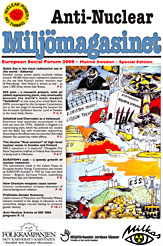Death Zones
Atomic deserts, 12-04-2011
http://www.spiegel.de/international/world/0,1518,756369-7,00.html
“The Soviet nuclear testing site in present-day Kazakhstan is just one of many places in the world that remain dangerously radioactive to this day.
Everyone knows about Chernobyl, Three Mile Island and, now, Fukushima. But what about Semipalatinsk, Palomares and Kyshtym? The world is full of nuclear disaster zones — showing just how dangerous the technology really is.
Wednesday, Mar. 28, 1979. In the Three Mile Island nuclear power station in Harrisburg, Pennsylvania, the nightmare scenario of nuclear physicists was about to unfold. At four in the morning, employees in the control room noticed the failure of a pump in the reactor’s water cooling loop. When a bypass valve failed to trip, water stopped flowing to steam generators, resulting in an emergency reactor shutdown. But the reactor continued to generate so-called decay heat. A relief valve opened automatically but then failed to close, allowing coolant to flow out at a rate of one ton per minute. The control panel erroneously indicated that the cooling system was functioning normally, meaning echnicians initially failed to recognize the problem. By 6 a.m., the top of the reactor core was no longer covered in cooling water – and the fuel rods began to melt. At the last moment, a technician noticed the problem and closed the relief valve. A full-scale meltdown was only barely averted. Still, the series of events had a devastating effect: Not only was radioactivity released into the atmosphere, but contaminated coolant escaped into the nearby river. Cancer rates in the local population later rose dramatically. In addition, large parts of the reactor and the power plant site were contaminated.
The clean-up operation in Harrisburg took 14 years and cost more than $1 billion. And the reactor ruins are radioactive to this day. The case is instructive. It was the result of tiny construction errors and a small dose of human error. And now, as the world watches on in horror as the catastrophe in Fukushima continues to unfold, the debate on the safety of nuclear power has been reignited. The area around Fukushima will likely remain contaminated for decades, if not centuries. And many are once again wondering if the returns from nuclear technology justifies the risks. How can anything be considered under control which can so quickly mutate into an apocalypse?
Sadly, though, disasters like Three Mile Island and Fukushima are not as rare as one would hope. There have been plenty of atomic accidents resulting in significant radioactive leaks, spills and explosions. And the Chernobly Exclusion Zone, for all the attention it gets, is far from the only nuclear no-go area on the planet. A look at some of the worst incidents is enough to demonstrate just how high the price of nuclear energy and nuclear weapons truly is.”
Part 1: A Survey of the World’s Radioactive No-Go Zones
Part 3: ‘Now I Am Become Death’
Part 4: Uninhabitable to This Day
Part 5: The Radioactive Dilemma
Part 6: Unrelenting Bombardment
Part 8: A Nuclear No Man’s Land
Part 9: Unfathomable Destruction
Part 11: The Irradiated Buddha
Part 12: Underground Time Bomb
Part 13: The First Big Accident
Part 16: Mushroom Clouds in the South Pacific

